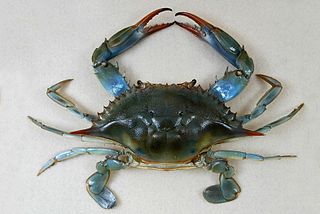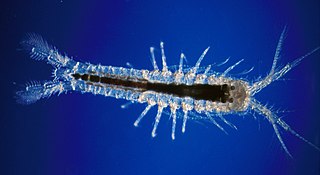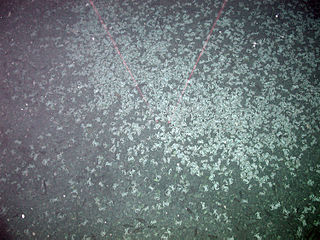Related Research Articles

Malacostraca is the second largest of the six classes of pancrustaceans just behind hexapods, containing about 40,000 living species, divided among 16 orders. Its members, the malacostracans, display a great diversity of body forms and include crabs, lobsters, crayfish, shrimp, krill, prawns, woodlice, amphipods, mantis shrimp, tongue-eating lice and many other less familiar animals. They are abundant in all marine environments and have colonised freshwater and terrestrial habitats. They are segmented animals, united by a common body plan comprising 20 body segments, and divided into a head, thorax, and abdomen.

Ocypode is a genus of ghost crabs found in the sandy shores of tropical and subtropical regions throughout the world. They have a box-like body, thick and elongated eyestalks, and one claw is larger than the other in both males and females. They inhabit deep burrows in the intertidal zone. They are primarily nocturnal, and are generalist scavengers and predators of small animals. The genus contains 21 species.

Leptostraca is an order of small, marine crustaceans. Its members, including the well-studied Nebalia, occur throughout the world's oceans and are usually considered to be filter-feeders. It is the only extant order in the subclass Phyllocarida. They are believed to represent the most primitive members of their class, the Malacostraca, and first appear in the fossil record during the Cambrian period.

Eucarida is a superorder of the Malacostraca, a class of the crustacean subphylum, comprising the decapods, krill, and Angustidontida. They are characterised by having the carapace fused to all thoracic segments, and by the possession of stalked eyes.

Alvinocarididae is a family of shrimp, originally described by M. L. Christoffersen in 1986 from samples collected by DSV Alvin, from which they derive their name. Shrimp of the family Alvinocarididae generally inhabit deep sea hydrothermal vent regions, and hydrocarbon cold seep environments. Carotenoid pigment has been found in their bodies. The family Alvinocarididae comprises 7 extant genera.

The superorder Peracarida is a large group of malacostracan crustaceans, having members in marine, freshwater, and terrestrial habitats. They are chiefly defined by the presence of a brood pouch, or marsupium, formed from thin flattened plates (oostegites) borne on the basalmost segments of the legs. Peracarida is one of the largest crustacean taxa and includes about 12,000 species. Most members are less than 2 cm (0.8 in) in length, but the largest is probably the giant isopod which can reach 76 cm (30 in). The earliest known perecaridian was Oxyuropoda ligioides, a fossil of which has been found dating to the Late Devonian of Ireland.

Eumalacostraca is a subclass of crustaceans, containing almost all living malacostracans, or about 40,000 described species. The remaining subclasses are the Phyllocarida and possibly the Hoplocarida. Eumalacostracans have 19 segments. This arrangement is known as the "caridoid facies", a term coined by William Thomas Calman in 1909. The thoracic limbs are jointed and used for swimming or walking. The common ancestor is thought to have had a carapace, and most living species possess one, but it has been lost in some subgroups.

Nebalia is a large genus of small crustaceans containing more than half of the species in the order Leptostraca, and was first described by William Elford Leach in 1814. The genus contains over thirty species:

Rostrum is a term used in anatomy for a number of phylogenetically unrelated structures in different groups of animals.

The Bythograeidae are a small family of blind crabs which live around hydrothermal vents. The family contains 16 species in six genera. Their relationships to other crabs are unclear. They are believed to eat bacteria and other vent organisms. Bythograeidae are a monophyletic, sister taxon of the superfamily Xanthoidea which split to inhabit hydrothermal vents around the Eocene.

Mictacea is a monotypic order of crustaceans. It was originally erected for three species of small shrimp-like animals of the deep sea and anchialine caves. They were placed in two families, the Mictocarididae and Hirsutiidae, but Hirsutiidae is now placed in order Bochusacea, leaving Mictacea with a single species, Mictocaris halope.
Nebaliopsis typica is a species of leptostracan crustacean, the only species in the genus Nebaliopsis. It is exceptionally large for a leptostracan, at up to 40 millimetres (1.6 in) in length, compared to 5–15 mm (0.2–0.6 in) for the other species. It is also the only species not to brood its eggs, but instead lays them directly into the water; correspondingly, there is no sexual dimorphism in Nebaliopsis.
Nebaliopsididae is a family of leptostracan crustaceans. It contains only two species, the bathypelagic Nebaliopsis typica and the mesopelagic Pseudonebaliopsis atlantica.
Joel W. Martin is an American marine biologist and invertebrate zoologist who is currently Chief of the Division of Invertebrate Studies and Curator of Crustacea at the Natural History Museum of Los Angeles County (NHMLAC). His main area of research is the morphology and systematics of marine decapod crustaceans.
Rhabdouraea bentzi is an extinct species of leptostracan crustacean which lived during the Permian, which is placed in its own genus, Rhabdouraea, and family, Rhabdouraeidae.

Crustaceans may pass through a number of larval and immature stages between hatching from their eggs and reaching their adult form. Each of the stages is separated by a moult, in which the hard exoskeleton is shed to allow the animal to grow. The larvae of crustaceans often bear little resemblance to the adult, and there are still cases where it is not known what larvae will grow into what adults. This is especially true of crustaceans which live as benthic adults, more-so than where the larvae are planktonic, and thereby easily caught.

Cyanagraea praedator is a species of crab that lives on hydrothermal vents, and the only species in the genus Cyanagraea.

Stenopodidae is a family of decapods in the order Decapoda, sometimes known as boxer shrimp. There are about 6 genera and more than 30 described species in Stenopodidae. The oldest record of the family dates to the Devonian.

Crustaceans are a group of arthropods that are a part of the subphylum Crustacea, a large, diverse group of mainly aquatic arthropods including decapods, seed shrimp, branchiopods, fish lice, krill, remipedes, isopods, barnacles, copepods, opossum shrimps, amphipods and mantis shrimp. The crustacean group can be treated as a subphylum under the clade Mandibulata. It is now well accepted that the hexapods emerged deep in the Crustacean group, with the completed group referred to as Pancrustacea. The three classes Cephalocarida, Branchiopoda and Remipedia are more closely related to the hexapods than they are to any of the other crustaceans.

The clade Multicrustacea constitutes the largest superclass of crustaceans, containing approximately four-fifths of all described crustacean species, including crabs, lobsters, crayfish, shrimp, krill, prawns, woodlice, barnacles, copepods, amphipods, mantis shrimp and others. The largest branch of multicrustacea is the class Malacostraca.
References
- 1 2 R. R. Hessler (1984). "Dahlella caldariensis new genus new species - a leptostracan (Crustacea, Malacostraca) from deep-sea hydrothermal vents". Journal of Crustacean Biology . 4 (4): 655–664. doi:10.2307/1548079. JSTOR 1548079.
- ↑ "Dahlella caldariensis". Grzimek's Animal Life Encyclopedia . 2003.
- 1 2 Genefor K. Walker-Smith & Gary C. B. Poore (2001). "A phylogeny of the Leptostraca (Crustacea) with keys to families and genera" (PDF). Memoirs of Museum Victoria . 58 (2): 383–410. doi:10.24199/j.mmv.2001.58.21. Archived from the original (PDF) on 2017-08-09. Retrieved 2009-02-27.
- ↑ Todd Haney. "Leptostraca Specimen Database Search". Natural History Museum of Los Angeles County. Archived from the original on 2008-10-10.
- ↑ Todd A. Haney, Robert R. Hessler & Joel W. Martin (2001). "Nebalia schizophthalma, a new species of leptostracan (Malacostraca) from deep waters off the east coast of the United States" (PDF). Journal of Crustacean Biology . 21 (1): 192–201. doi:10.1651/0278-0372(2001)021[0192:NSANSO]2.0.CO;2. JSTOR 1549768. Archived from the original (PDF) on 2011-07-27. Retrieved 2009-02-27.
- ↑ Todd Haney. "Synonymy". Los Angeles PEET project on Leptostraca. Natural History Museum of Los Angeles County. Archived from the original on 2008-09-06.